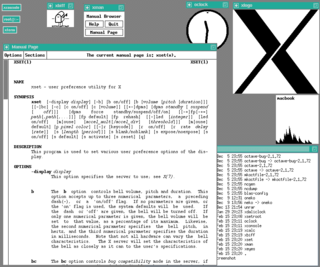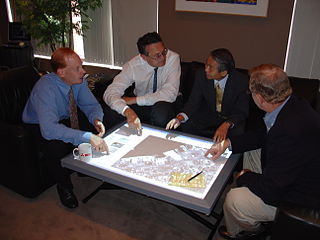DMI may refer to:
DMI may refer to:

VESA, formally known as Video Electronics Standards Association, is an American technical standards organization for computer display standards. The organization was incorporated in California in July 1989 and has its office in San Jose. It claims a membership of over 300 companies.
DCI may be an abbreviation for:
SSI may refer to:
A management information system (MIS) is an information system used for decision-making, and for the coordination, control, analysis, and visualization of information in an organization. The study of the management information systems involves people, processes and technology in an organizational context. In other words, it serves, as the functions of controlling, planning, decision making in the management level setting.
CMI may refer to:
DRI or D.R.I. may stand for:
An application program is a computer program designed to carry out a specific task other than one relating to the operation of the computer itself, typically to be used by end-users. Word processors, media players, and accounting software are examples. The collective noun "application software" refers to all applications collectively. The other principal classifications of software are system software, relating to the operation of the computer, and utility software ("utilities").
Interaction design, often abbreviated as IxD, is "the practice of designing interactive digital products, environments, systems, and services." While interaction design has an interest in form, its main area of focus rests on behavior. Rather than analyzing how things are, interaction design synthesizes and imagines things as they could be. This element of interaction design is what characterizes IxD as a design field, as opposed to a science or engineering field.

Alan Cooper is an American software designer and programmer. Widely recognized as the "Father of Visual Basic", Cooper is also known for his books About Face: The Essentials of Interaction Design and The Inmates Are Running the Asylum: Why High-Tech Products Drive Us Crazy and How to Restore the Sanity. As founder of Cooper, a leading interaction design consultancy, he created the Goal-Directed design methodology and pioneered the use of personas as practical interaction design tools to create high-tech products. On April 28, 2017, Alan was inducted into the Computer History Museum's Hall of Fellows "for his invention of the visual development environment in Visual BASIC, and for his pioneering work in establishing the field of interaction design and its fundamental tools."

A skeuomorph is a derivative object that retains ornamental design cues (attributes) from structures that were necessary in the original. Skeuomorphs are typically used to make something new feel familiar in an effort to speed understanding and acclimation. They employ elements that, while essential to the original object, serve no pragmatic purpose in the new system. Examples include pottery embellished with imitation rivets reminiscent of similar pots made of metal and a software calendar that imitates the appearance of binding on a paper desk calendar.
The following outline is provided as an overview of and topical guide to human–computer interaction:
DSI may refer to:

In computing, a shell is a computer program that exposes an operating system's services to a human user or other programs. In general, operating system shells use either a command-line interface (CLI) or graphical user interface (GUI), depending on a computer's role and particular operation. It is named a shell because it is the outermost layer around the operating system.
The Desktop Management Interface (DMI) generates a standard framework for managing and tracking components in a desktop, notebook or server computer, by abstracting these components from the software that manages them. The development of DMI, 2.0 version June 24, 1998, marked the first move by the Distributed Management Task Force (DMTF) into desktop-management standards. Before the introduction of DMI, no standardized source of information could provide details about components in a personal computer.
Engineering Animation, Inc., or EAI, was a services and software company based in Ames, Iowa, United States. It remained headquartered there from its incorporation in 1990 until it was acquired in 2000 by Unigraphics Solutions, Inc., now a subsidiary of the German technology multinational Siemens AG. During its existence, EAI produced animations to support litigants in court, wrote and sold animation and visualization software, and developed a number of multimedia medical and computer game titles. Part of EAI's business now exists in a spin-off company, Demonstratives.

Dubai Media Incorporated (DMI) is the official media organization of the government of Dubai. It was established in 2003 as a state-owned company comprising a number of print, radio and TV channels under its umbrella, including: Dubai TV, Al Bayan, Dubai One, Dubai Sports, Emirates 24/7, Tawseel and Masar Printing Press. The chairman of the board of directors of DMI, Maktoum bin Mohammed bin Rashid Al Maktoum, is also the deputy ruler of Dubai.

Interactive design is a user-oriented field of study that focuses on meaningful communication using media to create products through cyclical and collaborative processes between people and technology. Successful interactive designs have simple, clearly defined goals, a strong purpose and intuitive screen interface.

VTLS Inc. was a global company that provided library automation software and services to a diverse customer base of more than 1900 libraries in 44 countries. The for-profit company was founded in 1985 by Dr. Vinod Chachra, who became the President and CEO of the company. VTLS originated as "Virginia Tech Library Systems", an automated circulation and cataloging system created for Virginia Tech’s Newman Library in 1975. In addition to its headquarters in Blacksburg, Virginia, United States, VTLS had five international offices in Australia, Brazil, India, Malaysia and Spain. VTLS was one of the few ISO 9001:2008 quality-certified companies within the library industry for many years. The company was acquired by Innovative Interfaces in 2014.

The DiamondTouch table is a multi-touch, interactive PC interface product from Circle Twelve Inc. It is a human interface device that has the capability of allowing multiple people to interact simultaneously while identifying which person is touching where. The technology was originally developed at Mitsubishi Electric Research Laboratories (MERL) in 2001 and later licensed to Circle Twelve Inc in 2008. The DiamondTouch table is used to facilitate face-to-face collaboration, brainstorming, and decision-making, and users include construction management company Parsons Brinckerhoff, the Methodist Hospital, and the US National Geospatial-Intelligence Agency (NGA).